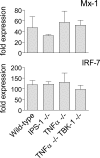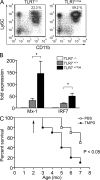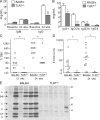TLR7-dependent and FcgammaR-independent production of type I interferon in experimental mouse lupus
- PMID: 19047436
- PMCID: PMC2605237
- DOI: 10.1084/jem.20080462
TLR7-dependent and FcgammaR-independent production of type I interferon in experimental mouse lupus
Abstract
Increased type I interferon (IFN-I) production and IFN-stimulated gene (ISG) expression are linked to the pathogenesis of systemic lupus erythematosus (SLE). Although the mechanisms responsible for dysregulated IFN-I production in SLE remain unclear, autoantibody-mediated uptake of endogenous nucleic acids is thought to play a role. 2,6,10,14-tetramethylpentadecane (TMPD; also known as pristane) induces a lupus-like disease in mice characterized by immune complex nephritis with autoantibodies to DNA and ribonucleoproteins. We recently reported that TMPD also causes increased ISG expression and that the development of the lupus is completely dependent on IFN-I signaling (Nacionales, D.C., K.M. Kelly-Scumpia, P.Y. Lee, J.S. Weinstein, R. Lyons, E. Sobel, M. Satoh, and W.H. Reeves. 2007. Arthritis Rheum. 56:3770-3783). We show that TMPD elicits IFN-I production, monocyte recruitment, and autoantibody production exclusively through a Toll-like receptor (TLR) 7- and myeloid differentiation factor 88 (MyD88)-dependent pathway. In vitro studies revealed that TMPD augments the effect of TLR7 ligands but does not directly activate TLR7 itself. The effects of TMPD were amplified by the Y-linked autoimmune acceleration cluster, which carries a duplication of the TLR7 gene. In contrast, deficiency of Fcgamma receptors (FcgammaRs) did not affect the production of IFN-I. Collectively, the data demonstrate that TMPD-stimulated IFN-I production requires TLR7/MyD88 signaling and is independent of autoantibody-mediated uptake of ribonucleoproteins by FcgammaRs.
Figures









References
-
- Reeves, W.H., S. Narain, and M. Satoh. 2005. Autoantibodies in systemic lupus erythematosus. In Arthritis and Allied Conditions: A Textbook of Rheumatology. 15th edition. W.J. Koopman and L.W. Moreland, editors. Lippincott Williams & Wilkins, Philadelphia. 1497–1521.
-
- Kirou, K.A., C. Lee, S. George, K. Louca, M.G. Peterson, and M.K. Crow. 2005. Activation of the interferon-alpha pathway identifies a subgroup of systemic lupus erythematosus patients with distinct serologic features and active disease. Arthritis Rheum. 52:1491–1503. - PubMed
-
- Baechler, E.C., F.M. Batliwalla, G. Karypis, P.M. Gaffney, W.A. Ortmann, K.J. Espe, K.B. Shark, W.J. Grande, K.M. Hughes, V. Kapur, et al. 2003. Interferon-inducible gene expression signature in peripheral blood cells of patients with severe lupus. Proc. Natl. Acad. Sci. USA. 100:2610–2615. - PMC - PubMed
-
- Zhuang, H., S. Narain, E. Sobel, P.Y. Lee, D.C. Nacionales, K.M. Kelly, H.B. Richards, M. Segal, C. Stewart, M. Satoh, and W.H. Reeves. 2005. Association of anti-nucleoprotein autoantibodies with upregulation of Type I interferon-inducible gene transcripts and dendritic cell maturation in systemic lupus erythematosus. Clin. Immunol. 117:238–250. - PubMed
Publication types
MeSH terms
Substances
Grants and funding
LinkOut - more resources
Full Text Sources
Other Literature Sources
Medical

